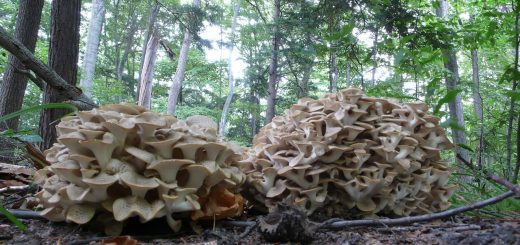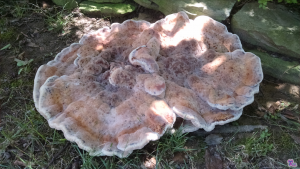#122: Sphaerobolus stellatus, the Artillery Fungus [Archived]
Note: this is an archived post. You can read the current version of this post here.
Happy New Year! To celebrate, I decided to use some fungal cannon fire to start 2016 off with a bang! Although it is tiny, Sphaerobolus stellatus gets just about as close as a fungus can to actually being a firework. The tiny, star-shaped fruiting bodies are designed to launch a spherical sac of spores high into the air. This unique spore dispersal strategy has resulted in a variety of common names, including: “Artillery Fungus,” “Cannonball Fungus,” “Cannon Fungus,” “Sphere Thrower” (which is a literal translation of its Latin name), “Shotgun Fungus,” “Shooting Star,” and “Bombardier Fungus.”
The most obvious trait these mushrooms have are the little, black dots that pepper nearby surfaces. S. stellatus grows on wood and especially likes eating mulch. This can cause headaches for homeowners, who regularly find the discharged spore sacs stuck to cars, siding, windows, etc. These dots are very difficult to remove and may stain the surface underneath them. The easiest solution is probably to repaint the affected surface. Getting rid of the Artillery Fungus itself is a more difficult problem. Like all other fungi, there is really no way to eliminate S. stellatus. It usually grows on hardwood, so switching to a conifer mulch can limit the fungus’s growth. The fungal spores can remain viable for over 10 years, so the fungus may reappear if hardwood mulch is used in the future.
S. stellatus grows up to 3mm across and is yellow-orange to whitish in color. This makes it nearly impossible to spot when growing on wood. Even I will most likely overlook the tiny mushrooms unless I know that they are present. Newly-forming fruiting bodies are white spheres that are too small to measure with a normal ruler. As the spheres get older, the top of the mushroom splits into between four and nine triangular rays, much like a minuscule earthstar. The inner surface of the mushroom is orange to yellow and bowl-shaped with a darker, spherical mass sitting at the bottom of the bowl. This darker sphere is the structure that contains the spores and is called a “peridiole” or “gleba.” Thanks to the presence of this peridiole, field guides usually place S. stellatus with the bird’s nest fungi. As the mushroom gets closer to releasing its spores, the peridiole grows to about 1.5mm in diameter and darkens to become reddish-brown to dark brown.
When the mushroom is fully mature, it releases its spores by mechanically launching the peridiole into the air. The top layer of the inner surface of the Artillery Fungus suddenly pops out, much like the safety buttons on top of sealed jars or the dice-rolling contraptions at the center of many children’s board games. This action is accompanied by a small popping sound reminiscent of that produced by Pop Rocks. Presumably, this motion is accomplished by increased osmotic pressure in the inner surface produced by glycogen being converted into sugars. The increased pressure results in the enlargement of cells in the membrane, which is then forced to pop out. This hypothesis has proven difficult to test, thanks in large part to the mushroom’s small size. Whatever the mechanism, it has some spectacular results. S. stellatus can throw its peridiole up to 14 feet (4.3 meters) high and 18 feet (5.5 meters) away. This would be equivalent to a six-foot-tall human throwing a baseball roughly 1.5 miles into the air and nearly 2 miles in distance. The mushroom can sense bright light and generally discharges its peridiole towards the nearest light source or reflective surface.
The peridiole is encased in a sticky coating that effectively glues the spore sac to any surface upon which it lands. Each peridiole contains two different types of cells, so there are two ways that S. stellatus grows after it lands on a viable surface. The spores germinate only after passing through the digestive system of a herbivore. Peridioles are often seen stuck to leaves of grasses and short plants, where they are likely to be eaten. The animals then provide a secondary means of spore dispersal. If the peridiole lands directly on wood, a second type of cell – large, oval-ish cells called “gemmae” – can germinate. Gemmae produce hyphae that can grow directly into a wood substrate.
There are actually three species of Sphaerobolus that occur in North America: S. stellatus, S. iowensis, and S. ingoldii. Only S. ingoldii can be differentiated from the others based on morphological analysis. This species forms peridioles that are 1mm in diameter, while the other two form peridioles roughly 1.5mm in diameter. All three of them can be differentiated after microscopic examination. S. iowensis has gemmae and Swiss cheese-like holes inside its peridioles called “basidial chambers.” S. stellatus also has gemmae, but lacks basidial chambers. S. ingoldii has neither gemmae nor basidial chambers.
All three Sphaerobolus species are widely distributed in North America, but S. ingoldii seems to be less common than the other two (and, of course, it’s the only one that I’ve found). Preliminary research suggests that in North America, S. iowensis is at least as common as S. stellatus. S. stellatus is distributed all across the world, although I am unaware of any studies examining the genetics of the S. stellatus clade on a global level. This could mean that there are more species hiding under the name S. stellatus. Sphaerobolus belongs to the phylum Basidiomycota, class Basidiomycetes, order Phallales, and family Geastraceae. This means that the Artillery Fungus is most closely related to the earthstars instead of the bird’s nest fungi. The name “Sphaerobolus” translates to “sphere thrower” and “stellatus” translates to “star-shaped.” S. ingoldii was named after a prominent mycologist and S. iowensis is, I believe, named after the U. S. state of Iowa.
See Further
http://botit.botany.wisc.edu/toms_fungi/jul2005.html
http://www.mycologia.org/content/97/3/680.full
http://www.mykoweb.com/CAF/species/Sphaerobolus_stellatus.html
http://www.ct.gov/caes/cwp/view.asp?a=2815&q=376840
https://extension.umaine.edu/ipm/ipddl/publications/5103e/
http://www.clemson.edu/extension/hgic/hot_topics/2010/03artillery_fungus.html
http://bie.ala.org.au/species/c49a1366-81ff-441e-ad85-8f8f1ae3e5ab








![#011: Characteristics of Kingdom Fungi [Archived]](https://www.fungusfactfriday.com/wp-content/themes/hueman/assets/front/img/thumb-small-empty.png)


2 Responses
[…] mushroom worth discussing here is Sphaerobolus stellatus (literally “star-shaped sphere thrower”), the “Cannonball Fungus.” This unique fungus […]
[…] Another common name is “Shotgun Fungus,” but that can also be applied to Sphaerobolus spp. (FFF#122), so I recommend against using that […]